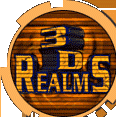






|
 |
Three new Prey Magazine Previews
Today we bring you some more Prey previews, this time coming from three print magazines that are available now. They're PC Gamer (Apr 2006), The Official Xbox Magazine (Mar 2006), & X360 Magazine (Apr 2006). All three of them really love the game, here's a bit of what they all had to say:
X360 Magazine:
"Literally, a gut wrenching experience"
"Prey surprised, shocked, and greatly excited us with its complexity, inventiveness, and sheer gorgeousness - this is a truly next-generation game."
"Prey merges elements from different FPS sub-generes to create an involving experience that is often quite disturbing."
"Prey certainly impressed us. Ten years of development has meant that the teams at 3D Realms & Human Head have had more than enough time to cram every last good idea into the game and make them all work together cohesively."
In addition to their preview, they have a prediction of the Top 10 games on the Xbox 360 for the year 2006. X360 Magazine lists Prey fourth on that list, behind Halo 3, and in front of Gears of War.
Official Xbox Magazine:
"It's the weaponry and the whacked-out room puzzles that got our shooter-loving blood pumping."
"All of the weapons in Prey are acquired on the ship, lending a definite air of alien wierdness to each one."
"But hands down, the enemy that wins the "Most Likely to Give you Nightmares" award are the Wraiths, a race of spectral beings that float around and possess beings. In one of the most distrubing scenes we've ever seen in a videogame, a Wraith files into the body of a little girl then then, possessed by evil, gleefully trips her brother to shreds."
"The game already looks very polished; the engaging mix of sci-fi and Native American themes intrigues us, not to mention all the cool gravity tricks where are available in multiplay, too."
PC Gamer:
"Invest in Milk of Magnesia - this shooter's not for the faint of stomach."
"Looks like 3D Realms has a real winner on their hands!"
"Both effects (portals & gravity shifts) are pretty disorienting, but extremely cool."
"Kudos to Human Head - I haven't had a multiplayer shooter experience this impressive in ages!"
You'll want to check all of these previews - they're not online, you have to go check out the magazines at your local newsstand!
Posted by Joe Siegler at 5:15 PM
|
 |
 |
 |
 |
 |
The Apogee Legacy #8 - Ken Silverman
Today our "Apogee Legacy" Interview series continues with its eighth edition, this time with Build engine programmer, Ken Silverman. Ken's work can be seen in several of our titles, most notable Duke Nukem 3D & Shadow Warrior. His Build engine has been used in numerous titles by other companies as well (there's a list here). Ken was an engine guy, he never had a released "game" like others in this series up to this point, but don't mistunderstand that. Ken's contributions to the success of our games have been huge, specifically Duke Nukem 3D & Shadow Warrior.
The Apogee Legacy
Past Pioneers of the Shareware Revolution
Issue #8 - Ken Silverman
1) How did you first come in contact with Apogee?
I wrote a letter to Scott Miller about marketing Ken's Labyrinth in October 1992, 3 months before the game was released. We didn't reach a deal at that time. In March 1993, Epic released Ken's Labyrinth - which caught Scott's attention. He and Mark Rein of Epic sent me competing offers until August, at which time I chose Apogee.
2) Was there a reason you decided to work with Apogee, say versus going on your own or working with another company?
Sure. Apogee offered me the best deal. Unlike Epic, they offered a good salary - a fantasy for a kid just getting out of high school. Also, I knew about Apogee's reputation of producing high quality games, so I knew there was likely to be long-term benefits as well.
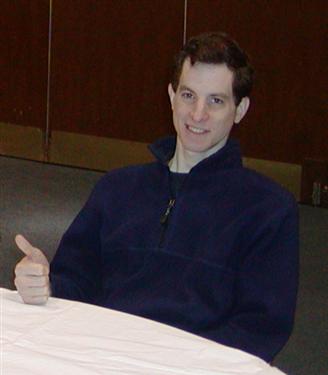
|
|
Ken Silverman - October 2005
|
3) Looking back, was there anything Apogee could have done better, regarding the marketing and distribution of your game?
No. I would look pretty silly complaining here when Duke Nukem 3D was the hottest selling game of 1996. Actually, now that I think about it... this slogan might have increased sales: "Duke Nukem 3D, from the makers of Ken's Labyrinth" Just kidding : )
4) Do you think your game was made better or worse by working with Apogee?
I wasn't really working on my own game. Supposing I had to do it all myself, I probably would have made something in the same style as Ken's Labyrinth, just with an updated engine. It might have looked a lot like the "KenBuild" test game on my website, or JFBuild (Windows port by JonoF). A commercial version would have included more maps, more crappy artwork, and a pointless story like "find some keys and exits because that's how you win". It would have been bad.
So my answer to this question is obviously yes. Apogee put a full committment into using my engine and tools. They took a risk by hiring a kid just out of high school to take on that kind of responsibility at their company. They did a great job on all aspects of the game.
5) Apogee had a policy of letting the designer or studio retain full intellectual property rights to their game. Nowadays, it's rare to find a publisher who allows this, especially if the publisher is providing the funding. Do you believe that it's best for the creator to retain IP rights? Why or why not?
In my case it didn't matter. My rights to the Build Engine were shared with Apogee/3D Realms. After I left the company, I did nothing to market the engine on my own. Any potential licensors dealt with Apogee/3D Realms, because that's who they knew about.
5a) And if applicable, have you benefited from retaining ownership of your own IP?
No. In retrospect, all it meant was that I didn't have to ask Apogee/3D Realms permission to release my own source code. I gave them a heads up anyway.
5b) Do you think there'll ever be a sequel to your game(s)?
For Duke Nukem 3D? Ha! You tell me : ) I can only speculate by pointing out that most mathematical models would suggest that the answer is no. After 10 years, I have no further information about this than a typical fan.

|
|
Ken showing off his US map drawing - Apr 1996
|
6) Is there any story/incident that stands out as interesting during your time associated with Apogee?
Sorry, I suck at remembering funny anecdotes. I didn't go out very much with the guys ... and when I did, I usually just sat there like a mute. It was hard being younger than everyone else.
7) Apogee was an early pioneer in terms of teaming up with external designers and studios, and continues to do so even to this day (currently working with Human Head Studios on Prey). Why is it that so few other studios do this (mentor and fund outside projects with lesser known teams)?
I can't speak for them. I can only guess that it has something to do with risk and them not wanting to take it.
8) What's the biggest difference in the industry nowadays versus when you worked with Apogee?
There's more interest and more competition now. Gaming is now as mainstream as movies. Online, I see lots of kids begging to get noticed - which is not unlike the struggling actors you see in Hollywood. Back then, I felt like an innovator for writing my own engine. Today, I am made to feel silly for not using an existing one. It hurts because I don't have the other skills.
9) What have you been doing since your time with Apogee?
I returned to Brown University in 1997 to finish college. Since graduating in May 2000, I've been working for myself. I still do the same amount of programming I used to, but I don't make money on it anymore. I release things on my website for free. Sometimes, I collaborate with friends online, such as Tom Dobrowolski (Voxlap/Moonedit) or Jonathon Fowler (JFBuild/JFDuke/JFSW). Also, I volunteer time at local schools, helping students with programming-related tasks. It's fun.

|
|
Ken with Frank Maddin in 1997 during Shadow Warrior development
|
10) If you're no longer making games, have you thought about returning to this industry? If not, why not?
I sometimes do small projects by myself and release them on my site, but nothing commercial. Most game companies in the New England area seem to be focused on money and business plans rather than making a fun game. I haven't looked too hard though. I'd rather be doing my own thing since I can.
11) Looking back, are there any missed opportunities that you wish you'd have jumped on?
No. I turned down a lot of offers in those days. In retrospect, I am very happy with the ones I chose.
12) Other than your game(s), what's your favorite game released or produced by Apogee (or 3D Realms)?
I guess Death Rally since it's one of the few games I've actually finished.
12a) And what's your favorite 2-4 games released by anyone else?
My favorite games of all time are:
- Pole Position: I loved the 3D effect at the time
- Super Mario Brothers: smooth scrolling, easy to play, great music
- Quake 3 Arena: great gameplay (with fast internet connection)
13) Is there anything else you'd like to add about your time here or to fans of your title(s)?
I've said enough. If you want more, or if you want to see my recent projects, you can visit my website: http://advsys.net/ken.
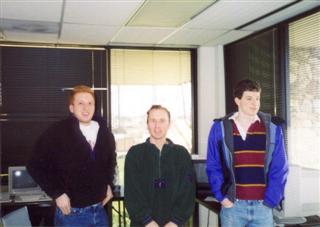 Ken (R) with his brother (L), and Duke Nukem programmer Todd Replogle at 3DR HQ.
Ken (R) with his brother (L), and Duke Nukem programmer Todd Replogle at 3DR HQ.
Thanks to Ken for sending in his answers, as well as a few pictures from his archives. Make sure and visit Ken's sites via the links in his answers above. However, our webmaster will relay a funny story as Ken said he wasn't good at that.
"One time the group of us were out to lunch at one of the local restaurants. This was one of the places that lets you draw with crayons on the table on paper they put on it. As Ken stated, he generally was pretty quiet, so most of us weren't paying attention, just talking the usual trash nonsense. After awhile one of us looked over at what Ken was doodling, and went "What the hell?" Ken was sketching the United States Map. He apparently has the ability to just draw the entire US map on anything. It pretty much took us by surprise, as he was roughly half done at that point, and from that point on we just watched him finish the map. One of the pictures above has another one of his "map doodles". So if you go anywhere with Ken, don't let him wander off on his own mentally, he'll draw the United States somewhere. :)"
Make sure and tune in again next Monday morning, when we bring you the next in our Legacy Interview series.
Posted by Joe Siegler at 12:31 PM
| Discuss this story on our forums
|
 |
 |
 |
 |
 |
Prey Weekly Development Update #7
Welcome to this edition of the Weekly Prey Update. This week, we're focusing on some of the questions we've received recently from you in our "Ask Prey" question a few weeks ago.
We received some really great ones -- far too many to be able to answer all of them in this one update. I'll save the other questions and try to answer many of them in a future Prey Update.
Without further ado, here are the questions and answers:
Travis asks:
Prey's caught my eye for a lot of its original and forward-thinking ideas. But there's a couple in particular that I'd like to hear more about. I hear that the game has a self-adjusting difficulty level. This worries me, because it supposes that there is a set degree of challenge that all gamers enjoy. Some less skilled players may want to play the game at a higher level because they enjoy a better fight, and some experienced gamers might just want a cakewalk on the first time through. Will there be a way to "bias" to difficulty adjustment to skew it higher or lower?
Also, I was wondering how the game is being balanced to preserve challenge with the Deathwalking element? Will enemies heal or respawn while the player is deathwalking so that when he returns he still has a real fight?"
The Dynamic Difficulty Adjustment (DDA) system has several different layers to it, the main one of which is based around combat. As you fight the various enemies the DDA system constantly monitors your progress: how quickly you kill each enemy, how much damage each enemy inflicted upon you before you killed it, and if the enemy managed to kill you. After the battle is over, the game uses that information to calculate how skilled you are against that particular enemy and slowly adjusts that enemy’s difficulty.
The DDA system also has the ability to do "spot fixes" where it detects if you are dying repeatedly in a given section. In that case, the system will slightly adjust the game to help nudge you past the section. Again, just a slight adjustment. The key to the whole system is to never make any dramatic adjustments, as that would be obvious to the player and break the immersion of the game.
You will be able to turn the DDA system off if you so desire.
DeathWalk: Enemies do not heal or respawn, but we are building in systems so that the player has a few seconds to get their bearings before the battle resumes -- for example, enemies are more likely to ignore you until you attack again after you resurrect.
Hayden asks:
"Of all the features of your game, the spirit walking interests me the most. How does it work? Is it an automatic trigger or manual trigger? Does it time out? Do you need some form of item to support it? If it's a manual trigger, how to you keep it from overpowering the gameplay? It seems overuse of that feature could make the gameplay too easy, making the game rather boring."
Once the player has obtained the ability to SpiritWalk (you cannot do this from the start of the game), they can SpiritWalk at any time, whenever they want.
We decided to not restrict the player from SpiritWalking, because so many puzzles rely upon leaving your body behind and venturing ahead in Spirit form to unlock areas or transport your body.
However, to balance this, you do not always have the ability to attack when in Spirit form. Only if you have enough Spirit Power can you use the Cherokee bow to attack enemies. Without that power you can still SpiritWalk, but you cannot attack.
We are pretty generous with Spirit Power, though as it turns out that it’s really fun and useful to leave your body behind and kill enemies with the Bow. And, it all depends upon how you want to play the game. Some of our internal testers like to leave their body and use the Bow often, whereas others prefer killing enemies with the more conventional weaponry.
Super_CK writes:
"I'm really looking forward to Prey, it's gonna be one of the best FPS' to come out in awhile. One thing that really has me curious though is the music. Most FPS games aren't really known for great music, but with Prey, it seems like there's a great opportunity to really have some good stuff going, considering the story and the main character. It kinda seems like the kind of score Jerry Goldsmith might write, if Prey were a big sci-fi action movie. Anyway, who's doing the music for the game? I really hope y'all got someone good."
We have about two hours worth of level music composed by Jeremy Soule and his brother Julian Soule, which is used both for ambient environmental music, as well as specific music (for boss battles and level stingers).
In addition, we have licensed various popular tunes for the bar scene in the game. I mean, what better way to get the feel of a roadhouse bar than having Judas Priest or Ted Nugent blaring out of the jukebox?
Spooger writes:
"I've read that Human Head is trying to make Prey as emotionally-charged as possible. Without giving away much story, what exactly is Human Head doing to ensure that Prey establishes itself as more than just a shoot-'em-up in terms of the story, character development, and how those elements will be presented."
Great question. As you mention, I can't say much without giving away too much of the story -- especially about the emotional moments. But, in terms of character development, very early in the game we deal with the theme of Tommy rejecting his heritage as he's talking to his grandfather and his girlfriend.
In terms of fleshing out the character of Tommy -- in true 3DR fashion the main character talks throughout the game. However, he's not just spouting out one-liners (Tommy does, however, have a number of amusing comments). Tommy's dialog is intended to reflect how a real person would react if put into this horrible situation.
Also, dude, you need a new handle. :)
Kreg asks these three questions:
"Will Duke Nukem get a special appearance in Prey ?
Will there be puzzles in Prey ?
Will there be space war (dog fight) in Prey ?"
1) Probably not. There are some fun secrets in the game, though.
2) Yes, definitely. The gameplay mechanics of SpiritWalking, WallWalking, Gravity Flipping and Portals all lend themselves to making some really mind-bending puzzles. We'll definitely be releasing more videos showing some of these puzzles in more detail.
3) Oh yes. The main vehicle in the game is a flying shuttlecraft (it's shown briefly in the E3 video). In that ship, you engage in space battles against flying enemy creatures as well as enemies piloting other shuttlecrafts.
Lionel asks:
"I was wondering what kind of (new) tools/features are included with prey for the mod community?"
We will be releasing all of the primary built-in tools for the game. We've made a number of minor changes to the Doom3 level editor (now dubbed Preditor). But, overall, if you're familiar with Doom3 level editing, you'll have no problem making Prey levels. Although, it will take a bit of a paradigm shift to think about ways to structure your levels around gravity flipping, wallwalking and portals.
Jouni had this great question:
"I'd love to know how much of the original 3D Realms design can we actually see in the final game? I mean, are some monsters / weapons / settings based on the original designs, or was the entire game "re-imagined" (as Hollywood likes to say it)? And if so; Was it hard to improve something as solid and innovative as 3DR's original Prey concept?"
Not much. When Human Head started on Prey, we worked from the core concept of a Native American reluctant hero who is abducted by aliens, and must fight his way back home. This was the core element that 3DR required carry across from the original design (well this, and of course portal technology).
While working with Scott and George, these elements were the ones they required. A few times we started to stray from these core elements, but they ensured that we stayed on track.
Everything else in the game, we were given free reign to design as we wanted. So, all the creatures, weapons, and other gameplay elements (such as wallwalking and gravity flipping) were designed here at Human Head. Of course, 3DR gave feedback and suggested enhancements to all these gameplay elements as we they were designed and implemented.
Kevin asks:
"How many vehicles will be in the game? Will vehicles be featured in any of the multiplayer maps?"
The primary vehicle in the game is the Shuttle, which is a one-man hovercraft which has a rapid projectile attack and short-range tractor beam as a secondary ability. The Shuttle is featured heavily in several maps, as the player pilots across enormous outdoor spaces in the game, fighting flying creatures and using the tractor beam to clear away obstacles.
The Shuttle is also available in multiplayer -- two of the DM maps are based around Shuttle combat.
Daniel asks:
"I was wondering what the difference will be between the PC and Xbox 360 versions of Prey. The best example I can think of was in Doom 3, the levels were "shortened" but you wouldn't know it without a side by side comparison. Quake 4 had something similar, but nothing really that noticable."
The content between the two are identical. No drastic changes were needed for the levels to get them to run on the 360. When 360 development was just starting, we did split several of the levels in half for memory reasons, but that was done to the PC version as well.
That said, we aren't opposed to making changes to the levels if necessary. Ideally, though, we'd simply do those changes to both versions to keep them identical (and to reduce the headaches of maintaining multiple versions of content).
Doom 3 was on the original Xbox, so I can see why those levels were shortened and altered. If Prey had to fix on the original Xbox, we would have had to do some pretty radical changes to the levels to get them to fix and to run at a decent framerate.
Well, that wraps it up for these questions. Again a huge thanks to everyone who wrote in with such great questions.
Next week's update should be damn cool as we talk more about Prey on the Xbox 360, with an update by the Studio Head of Venom Games, Peter Johnson.
Chris Rhinehart - Prey Project Lead
Human Head Studios

Click the screenshot to watch Prey in action on the videos page!
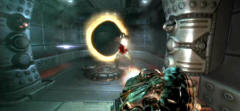

Additionally, if you are a gaming news website, and wish to be updated directly with notification of these updates, please email us with a link to your website and a request to be added, and we'll email you with the next update.
Posted by Joe Siegler at 12:00 PM
|
 |
 |
 |
 |
 |
The Apogee Legacy #7 - John Passfield
 Today our "Apogee Legacy" Interview series continues with the seventh edition, this time with John Passfield. John was one of the creators of our 1994 title, "Halloween Harry" (later renamed to Alien Carnage). John's influence went beyond that though as some people who worked with him on Harry also worked with us on other projects, too (Balls of Steel and Mystic Towers come to mind here). Today our "Apogee Legacy" Interview series continues with the seventh edition, this time with John Passfield. John was one of the creators of our 1994 title, "Halloween Harry" (later renamed to Alien Carnage). John's influence went beyond that though as some people who worked with him on Harry also worked with us on other projects, too (Balls of Steel and Mystic Towers come to mind here).
Carnage/Harry is unique in our product line, as it's the only game title to have a name change after it was released. That frequently happens with titles before they come out, but not afterwards! John continues to be a successful game developer in Australia, and was more than happy to help out with our Legacy series.
The Apogee Legacy
Past Pioneers of the Shareware Revolution
Issue #7 - John Passfield
First, in a little break from the norm, John also sent in a bio about himself to go with the interview:
John Passfield is a veteran of the computer games industry with more than 20 years professional experience as a games designer, lead programmer and scriptwriter on numerous award-winning titles. He is also credited as a founding member of the Australian games development community and helped establish some of the first development houses.
John was also a founding director of Krome Studios and co-created their flagship TY the Tasmanian Tiger series. He also created and owns the innovative Halloween Harry, Jaruu Tenk and Flight of the Amazon Queen properties. John is now the Creative Director of Pandemic Studios Australia.
1) How did you first come in contact with Apogee?
We're based in Brisbane, Australia and we were in discussion with Ian Mackay of Mannacom, a local software distributor to publish Halloween Harry. He happened to handle a lot of Apogee games - so we signed a deal with him and he hooked us up with Apogee.
2) Was there a reason you decided to work with Apogee, say versus going on your own or working with another company?
We really wanted to retain our Intellectual Property (IP) and weren't going to hand it over to anybody - and Apogee was very developer friendly.
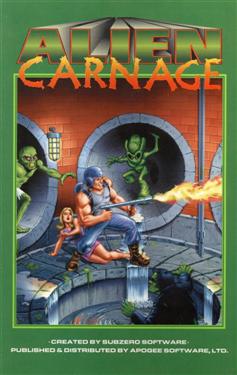
|
|
Alien Carnage Print Manual Cover
|
3) Looking back, was there anything Apogee could have done better, regarding the marketing and distribution of your game?
They did a pretty good job except I remember one of our European distributors stiffed Apogee and didn't pay up royalties. Apogee decided not to pursue it for whatever reason and we lost a lot of our European sales. Which sucked.
4) Do you think your game was made better or worse by working with Apogee?
From what I can remember Apogee had a very hands off approach. We pretty much made the game and let them sell it. So I don't think the partnership had any impact on the actual game. But they certainly helped get it out to the world and make us some money.
Looking back, I think we could have been more involved in the process. We were young, naïve and thought we knew it all. In hindsight I should have jumped on a plane and met up with Scott and George in person and talked about how to market the game and how to grow our business. I think we could have learned a lot from the guys and could have grown the Aussie industry a lot sooner.
5) Apogee had a policy of letting the designer or studio retain full intellectual property rights to their game. Nowadays, it's rare to find a publisher who allows this, especially if the publisher is providing the funding. Do you believe that it's best for the creator to retain IP rights? Why or why not?
Nowadays, it's rare to find a publisher who allows this, especially if the publisher is providing the funding. Do you believe that it's best for the creator to retain IP rights? Why or why not? Personally I like to own my IP. But realistically ideas are a dime a dozen. I think it's more important for developers to create quality games on time and budget and build up their reputation first. Then they can worry about owning their own IP. And remember, IP is useless unless you do something with it.
5a) And if applicable, have you benefited from retaining ownership of your own IP?
Well, the IP is generally owned by the developer - which is usually a company. In the case of TY the Tasmanian Tiger, an IP I created with Steve Stamatiadis the company we created, Krome Studios, owned that IP. As soon as I sold my share in Krome Studios I lost any interest in the property. So unless you have the IP assigned to you personally you're still in the same position as working for a publisher that owns the rights. However, when I left Krome I made sure that I was personally assigned the rights to a number of IPs that I helped create over time including Halloween Harry, Flight of the Amazon Queen, Mystery Club, Jaruu Tenk, Shadow Town, etc. I can exploit these IPs anyway I want and in some cases can derive extra revenue from them.
5b) Do you think there'll ever be a sequel to your game(s)?
Yes. I'm currently working with an independent developer to produce something new with the Halloween Harry license.
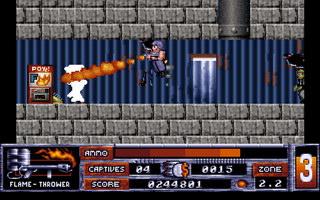
|
|
Screenshot from Alien Carnage
|
6) Is there any story/incident that stands out as interesting during your time associated with Apogee?
I remember visiting Ian Mackay at the Brisbane office of Mannacom in 1993 to show off the latest build of Halloween Harry and he had just received a build of the new id game from Apogee. We gathered around the PC to witness a game that very few people had yet seen: DOOM. That was pretty amazing. Here was a fast paced 3D game that would change the way games were made, and there we were with a quaint 2D side scroller!
Ed Note: In its earliest incarnation, the original Doom was still a project that id was working on to be published through Apogee. id then decided to "do their own thing" during the title's development.
7) Apogee was an early pioneer in terms of teaming up with external designers and studios, and continues to do so even to this day (currently working with Human Head Studios on Prey). Why is it that so few other studios do this (mentor and fund outside projects with lesser known teams)?
I think most publishers and developers are risk averse. I know of one company that was developing handheld games but no one would sign them. A local independent company partnered with them so they could port their PS2 game to the GBA. As soon as the GBA title shipped publishers signed them up because they were now "real" developers. That is so very typical.
8) What the biggest difference in the industry nowadays versus when you worked with Apogee?
Well, in the console space the budgets have grown obscenely large. But in the PC space I think it's gone full circle. I see Casual Games as being very similar to shareware back in the nineties. Games are developed by a small group of passionate developers, there is a try before you buy policy and most games are independent productions. But since the nineties shareware scene there have been some amazing improvements with the Casual Games industry. BBSes, for example, have been replaced by the web, everyone now uses credit cards and aren't afraid to buy stuff online, and development costs are much cheaper and the potential audience is much, much larger. There are no excuses for wannabe games makers to not make and market games today.
9) What have you been doing since your time with Apogee?
Well, I founded Krome Studios, one of Australia's largest games development companies and have worked on almost twenty published games. I recently sold my share in Krome and have joined the Pandemic Studios Australian team as their Creative Director. I've also been creating shareware style games in my spare time - the latest one being Word Shake which is available from Casual Games Arcade. I've also married and started a family - which is one of the best projects I've had the privilege of working on!
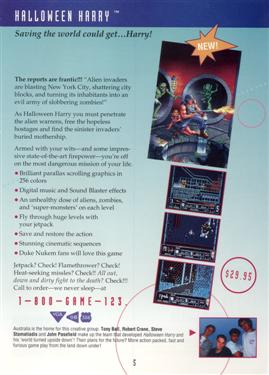
|
|
Halloween Harry from our 1993 Print Catalog
|
10) If you're no longer making games, have you thought about returning to this industry? If not, why not?
N/A
11) Looking back, are there any missed opportunities that you wish you'd have jumped on?
Professionally, we didn't have a viable business until 1999 when we formed Krome Studios. I think that moving to the States when Alien Carnage/Halloween Harry came out would have accelerated that process by at least five years. So I think I missed the opportunity to grow the business faster - but you live and you learn!
12) Other than your game(s), what's your favorite game released or produced by Apogee (or 3D Realms)?
Wolfenstein 3D was pretty cool!
12a) And what's your favorite 2-4 games released by anyone else?
My favourites are Monkey Island, Day of the Tentacle, the Zelda series and Mario 64.
Just recently I've been digging the new games on PSP and Nintendo DS - Mario Kart, GTA: Liberty City Stories and Animal Crossing all rock. I love these new handhelds!
13) Is there anything else you'd like to add about your time here or to fans of your title(s)?
Check out Casual Games Arcade to grab some quality PC and Mac games. These are the spiritual successors to the shareware games we grew up with! Oh, this is probably the place where you'll see the new Alien Carnage/Halloween Harry game first!
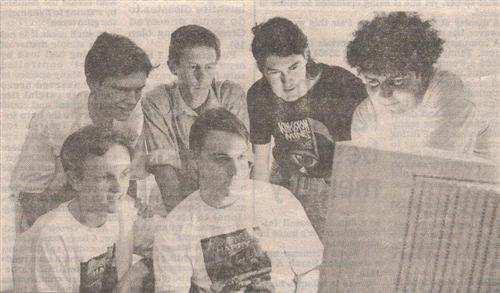 The Alien Carnage team from a newspaper scan in 1994.
The Alien Carnage team from a newspaper scan in 1994.
Top Row (L-R): Darren Baker, Tony Ball, John Passfield, Steve Stamatiadis
Bottom Row (L-R): Steven Baker, Robert Crane
Thanks to John for taking the time to send in his interview, as well as the old newspaper clipping image. While Alien Carnage is no longer available from us (it was discontinued a few years ago), his other projects are up and running. Check 'em out:
There is also more information on Carnage/Harry on our archived catalog page for the game here. There's more to read over at Classic DOS Games Archive. Finally, you'll want to read the Halloween Harry entry in the Apogee FAQ, which talks not only about the game's name change, but the two sequels to the game (Zombie Wars & Halloween Harry 3D), as well as an aborted TV series about the game.
Make sure and tune in again next Monday morning, when we bring you the next in our Legacy Interview series.
Posted by Joe Siegler at 12:00 PM
| Discuss this story on our forums
|
 |
 |
 |
 |
 |
Prey Weekly Development Update #6
Prey is the first product in which Human Head has used motion capture. In the past, we've always hand-animated our characters for a few different reasons - we know the time and effort it takes to animate a given character, we know what the results will look like, and because we needed the ability to easily tweak the animations. In Rune, the attack animations required a lot of tuning and tweaking throughout development. Now, in Prey - we decided during development to try using motion capture on our human characters, Tommy, Jen, Tommy's Grandfather, and various human NPCs that Tommy encounters on the Sphere.
Since we had never done motion capture before, honestly, we flew a bit blind at first. We first developed a comprehensive list of all animations in the game that would benefit from motion capture, this included such things as:
- Player animations (carrying each weapon, running, crouching, etc)
- Human NPC animations (idles, walks, runs, attacks, etc)
- Humanoid Creature animations (idles, attacks, runs, pains, etc)
- Experimental animations - ones that we felt might be better to hand animate, but wanted to try motion capture to see how that would work (a character floating inside of a tank is an example)
- All cinematic animations of characters walking from a specific point to a point, body language and gestures, etc.
Jeff DeWitt, Lead Animator on Prey, developed this comprehensive list from the creature AI list and from the script.
A small group of us then sat down and went over this list, expanding it as necessary by discussing what was needed, and even acting out parts of the script to get a better feel for what we would need.
Finally, with list in hand, Jeff and I headed down to Red Eye Studios, in Chicago for the actual mocap session.
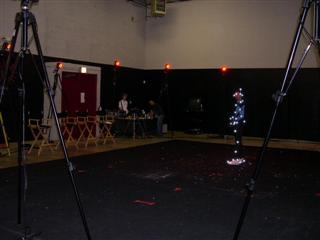 Here's a shot of the overall mocap studio. We're reviewing a previous animation at this point, so Geno (the actor who plays all the male character roles) is standing in the center waiting for direction. You'll notice that his suit contains a lot of reflective balls, each of these are recorded by the motion capture system to translate his body position into animation data.
Here's a shot of the overall mocap studio. We're reviewing a previous animation at this point, so Geno (the actor who plays all the male character roles) is standing in the center waiting for direction. You'll notice that his suit contains a lot of reflective balls, each of these are recorded by the motion capture system to translate his body position into animation data.
The motion capture only lasted two days - the first day consisted of all of the female motion capture, and a few scenes where we needed multiple actors interacting with each other.
Grace McPhillips performed the role of all the female characters in the game - she did a great job despite the abuse she took (at one point, we hoisted her up in the air - for the floating in tank section I mentioned before) and then motion captured her while she was dropped to the ground. Yes, there was a mat there to protect her.
The next day, Geno Kett showed up to perform the male character roles. Like Grace, he did a great job acting out what we wanted and he took his abuse really well. One of the more interesting parts was getting the runs for multiplayer - in MP the player actually runs at an unrealistically high rate (the MP is designed for fun action, not 100% realism). We marked out the run speed on the floor in chalk and did take after take until Geno got as close as possible to the speed we wanted.
Speaking of chalk: We learned a pretty valuable lesson (one that other people who have done mocap before will say sounds like common sense): plan out your animations around foot placement and make sure you chalk the foot placement right away. A few times we would be a few animations into a sequence and realize that the foot placement had moved - and then would have to go back and reshoot the previous animations again to guarantee that the actor’s feet had not moved.
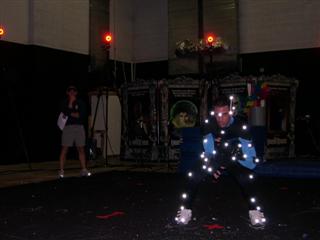 Here Geno is acting out the role of a scared human trapped on
the Sphere cowering for his life. Jeff DeWitt of Human Head stands in the background directing him.
Here Geno is acting out the role of a scared human trapped on
the Sphere cowering for his life. Jeff DeWitt of Human Head stands in the background directing him.
If we use motion capture again, we’ll definitely plan things a bit more around foot placement, so that we record a series of animations in a row before the actor has to move their feet.
For cinematic purposes, we brought along the entire dialog to play for the motion capture actors. In directing these sequences, we explained the situation, and the general mood of the scene. Then, we played the audio of the dialog a few times so they were comfortable with it, then they simply acted along with the dialog. Typically it took a few takes but eventually we hit upon something that worked.
In the end, the motion capture has been a mixed issue - some sequences worked out really great when motion captured and definitely saved some time. Other sequences turned out okay and are currently undergoing in-house tweaking to get rid of some motion capture artifacts. A few animations probably shouldn’t have been motion captured in the first place, so they’ve been thrown out and replaced with hand animation.
Will we use motion capture in the future? Yes, we will - but, like most aspects of development, it’s a tool that can be used in certain places for certain things. Now having a better knowledge of the overall system and the planning required for it, we certainly will be more efficient next time.
Next week on the weekly update, we’ll be answering some of the questions that were emailed over this past week on Prey. And in a couple of weeks, we’ll have a special update focusing on the Xbox 360 version, written by the studio head of Venom Games. Venom are responsible for the 360 version of Prey. Should be great stuff!
Chris Rhinehart - Prey Project Lead
Human Head Studios
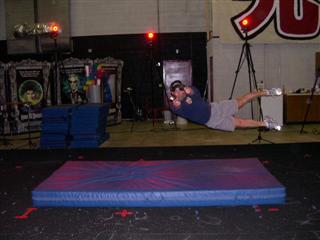 At one point the motion capture system's hard
drive was full. So we had a few minutes while they cleared out some space. I talked Jeff into Max Payne'ing onto one of the stunt mats. Six jumps (and a bruised shoulder) later, we snapped this fine shot.
At one point the motion capture system's hard
drive was full. So we had a few minutes while they cleared out some space. I talked Jeff into Max Payne'ing onto one of the stunt mats. Six jumps (and a bruised shoulder) later, we snapped this fine shot.

Click the screenshot to watch Prey in action on the videos page!


Additionally, if you are a gaming news website, and wish to be updated directly with notification of these updates, please email us with a link to your website and a request to be added, and we'll email you with the next update.
Posted by Joe Siegler at 2:53 PM
|
 |
 |
 |
 |
 |
The Apogee Legacy #6 - Mike Voss
Today our "Apogee Legacy" Interview series continues with its newest edition, this time with Mike Voss, author of the 1994 game, "Hocus Pocus". Mike only did one title with us, but it was a memorable one; it was a great entry in Apogee's long line of sidescroller titles. Mike (who we have no pictures of) no longer works in the game industry but was very happy to be interviewed about his game with us now 12 years ago.
The Apogee Legacy
Past Pioneers of the Shareware Revolution
Issue #6 - Mike Voss
1) How did you first come in contact with Apogee?
I was playing around with the idea of writing a shareware game around 1991. I started with a graphical adventure style game that ended up tired and boring after a while. Then I was inspired by Duke Nukem! I studied the game and figured that I might be able to tackle a similar style game. I was somewhat pessimistic about the idea of the shareware marketing model paying off until, in a local specialty magazine store, I came across "shareware magazine" and thumbed through it. I read in an article that Apogee was receiving about 300 orders per day.
I began to devote a large amount of time to programming. I created a game called Clyde's Adventure and tossed it into the shareware arena. The game was a modest success. I could almost make a small and very modest living. Very very modest. After a few months I received a letter from Scott Miller suggesting that possible fame and fortune was on my doorstep. Apogee offered to publish my next game. I said okay.
2) Was there a reason you decided to work with Apogee, say versus going on your own or working with another company?
Given that Clyde's Adventure was a small, run and hop type game, it wasn't as if Electronic Arts and Sierra was banging on my door. Further, I never really intended to make a career out of programming games. Apogee was offering to market my work and toss a chunk of the profits my way. It was a win-win proposal. I worked with Apogee because they asked me to.
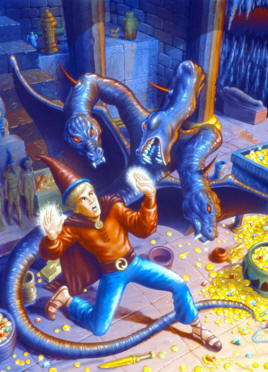
|
|
Hocus Pocus Game Manual Artwork
|
3) Looking back, was there anything Apogee could have done better, regarding the marketing and distribution of your game?
Hocus Pocus was released immediately following the release of Raptor. I saw full page ads in gaming magazines for Raptor. I saw no advertising for Hocus Pocus. At the time I felt cheated. Apogee always presented their company image as "not like the other companies" and that all games are given equal attention. I recall hearing George Broussard mention to me that "advertising does not do much to improve sales." I couldn't believe that he was telling me this. I understood the logic: Raptor sold better than Hocus Pocus. A dollar spent advertsing Raptor would always bring in more money that a dollar spent advertising Hocus Pocus. It was simple business sense not to spend money advertising my game. Still, I felt that I was unfairly treated. I got over my resentment on a recent Dr. Phil show, perhaps you saw it.
4) Do you think your game was made better or worse by working with Apogee?
Apogee absolutely made my game better. They had contacts for sound engines, music, art, etc. I hammered out Hocus Pocus on a 386 20 Mhz machine with an old 10 meg hard drive. My monitor died on me and for a few weeks I was using an old sony 6 inch black and white monitor. You might go so far as to say that my resources were on the lean side.
5) Apogee had a policy of letting the designer or studio retain full intellectual property rights to their game. Nowadays, it's rare to find a publisher who allows this, especially if the publisher is providing the funding. Do you believe that it's best for the creator to retain IP rights? Why or why not?
Given that I have kept my head out of the computer gaming business for the last ten years, I don't feel that I'm qualified to give a good opinion about this issue.
5a) And if applicable, have you benefited from retaining ownership of your own IP?
No response to question.
5b) Do you think there'll ever be a sequel to your game(s)?
Hocus Pocus 2: With a Vengence.
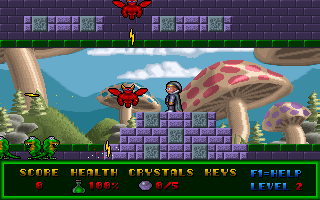
|
|
Screenshot from final version of Hocus Pocus
|
6) Is there any story/incident that stands out as interesting during your time associated with Apogee?
The best time I had working with Apogee was meeting Jim Dose. Jim was working on the Apogee sound system in New York and I would have long phone conversations with him on many occasions. He later ended up working with Apogee in Texas. Although we never met in person, Jim was one of the best people I met in the gaming industry.
7) Apogee was an early pioneer in terms of teaming up with external designers and studios, and continues to do so even to this day (currently working with Human Head Studios on Prey). Why is it that so few other studios do this (mentor and fund outside projects with lesser known teams)?
Companies tend to continue with what works for them. Apogee started out by working with outside companies so it's no surprise that they continue this practise.
8) What the biggest difference in the industry nowadays versus when you worked with Apogee?
Again, I have been out of the gaming industry for so long, I don't know too much about the changes that have occurred.
9) What have you been doing since your time with Apogee?
Shortly after I started developing Hocus Pocus, I got married. Apogee advanced us $5,000.00 to help us financially, the advance was free of interest for more than a year. Kudos to Apogee for a class act.
We now have two children, Jacob, who is six and Heather who is four. We have a small house in the suburbs and lead a comfortable and calm existence.
Like 98% of programmers, I began to do commercial web programming during the dot com bubble until it popped. My hobby now is playing with my kids and hoarding Google stock.
In a rather strange career move, I am currently completing my training to become a paramedic in the spring. Adios, programming.
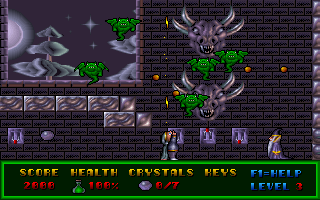
|
|
Screenshot from final version of Hocus Pocus
|
10) If you're no longer making games, have you thought about returning to this industry? If not, why not?
Sheesh, no. The industry now is so different from the small development teams that I worked with. If I'm not the star of the show, so to speak, then I don't want to be involved. Nowadays, to be a star, you need an IQ like a phone number. I dropped out of the game programming industry after id software wrote a little ditty called Doom. I could not compete with that. I tried for a little while, and just when I was getting the 3D concepts, they released Quake!
11) Looking back, are there any missed opportunities that you wish you'd have jumped on?
I believe that all things happen for the best, good or bad. We learn from bad experiences and profit from good experiences. Regret is like driving while looking in the rear view mirror.
12) Other than your game(s), what's your favorite game released or produced by Apogee (or 3D Realms)?
Halloween Harry is my favorite Apogee game.
12a) And what's your favorite 2-4 games released by anyone else?
Civilization
Doom I and II
All MS Flight Simulators
All Sim City's
13) Is there anything else you'd like to add about your time here or to fans of your title(s)?
My deepest appreciation goes out to everyone who played and enjoyed Hocus Pocus. Even the ones who enjoyed the pirated copies. (George will hate me for saying that.)
I'd also like to thank Scott Miller, George Broussard, Todd Replogle, Jim Dose, Jason Blochowiak and my beta testers, Andre Foucault and Chris tenDen.
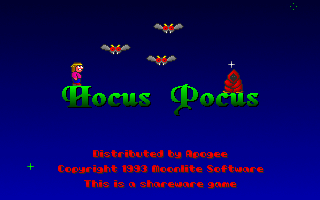
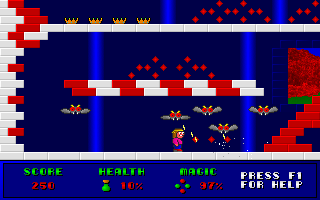
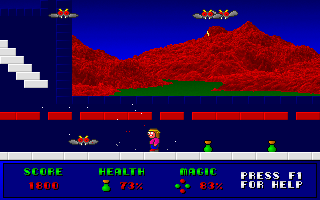 Screenshots from early build of Hocus Pocus in March 1993.
Screenshots from early build of Hocus Pocus in March 1993.
Thanks to Mike for taking the time to send in his interview. We still sell Mike's game, and it's still a good sidescroller game. You can check out the shareware version on the downloads page, or you can buy the registered version here. There's also some more information about Hocus Pocus on our catalog page for it here.
Make sure and tune in again next Monday morning, when we bring you the next in our Legacy Interview series.
Posted by Joe Siegler at 12:21 PM
| Discuss this story on our forums
|
 |
 |
 |
 |
 |
Prey Weekly Development Update #5
Hello again. Welcome back to the Prey Weekly Development Update.
Last week, we talked about the voice recording in the game. This week, it's back to the usual status update - with something at the end of this update talking about the plans for next week. In the immortal words of Mills Lane: Let's get it on...
First big thing to update on is the huge number of Prey previews hitting the net. These are all the results of the press tour from a few weeks ago, both when I was in Los Angeles/San Francisco and when Tim Gerritsen was touring through Europe. Joe from 3DR has set up a great page linking all the previews (as well as other Prey news).
Check them out - the response has been very positive, and each preview has different skews on the game. Some talk more on the single-player experience, while others focus on multiplayer or 360. And, if you haven’t seen the newly released single player and multiplayer videos -- well, dammit, go check them out. Here’s a link. They're also in the videos section of the Official Prey Site.
Speaking of Europe: Prey’s lead programmer, Paul MacArthur, spent some time last week in England visiting Venom. Venom, you may recall, is working on the Xbox 360 version of Prey. Paul was out there to meet with them face-to-face to discuss a host of issues, ranging from recent bugs to optimizations.
Meanwhile, back in Madison, Wisconsin. We’ve been receiving a large amount of feedback from 3DR on the game - listing bugs, tweaks, and game balance issues. In addition, 2K Games' QA department has been steadily adding bugs to the database.
Overall, it’s been business as usual around here. Everyone is cranking on the game, fixing bugs, optimizing code and levels, and tweaking things based upon 3DR’s feedback.
A number of new portal puzzles have been added to Prey, especially at the beginning. We felt that the portal usage could get even more intense earlier in the game, so we’ve been adding in even more puzzles and mind-warping portal coolness. I’d go more into the puzzles themselves, but I honestly don’t want to spoil these.
We’ve also been focusing on the combat in the game. The combat is definitely fun as it currently is, but we’re working with 3DR to tweak it to be super-fun. We aren’t doing anything radical to the monsters - the main things that we’re doing to beef them up is based around feedback and around sustained intensity.
AI Feedback relates to the information the player receives during combat: - Pain noises from the creatures
- AI chatter: The creatures yelling taunts at the player and issuing commands to each other
- Louder and more dramatic damage noises (sticky thuds when striking something with the wrench, or a great sizzle when hitting something with the Acid Sprayer)
- More visible and satisfying effects such as blood spurts and weapon damage effects
- More visible pain animations on the creatures
Sustained intensity in a fight relates to keeping the battle going for a longer period of time. Now there are a few ways this can be done, but for simplicity think of it like this: CreatureLifeTime * CreatureCount. You could fight one creature that lives a long time during the battle, or four creatures that live only 25% of the time of that one creature.
Which battle do you think would be more fun? Both can be fun, but in my opinion, the second one - you get the reward of killing four creatures instead of the one. Of course, the issue is way more complex as this doesn’t address the number you are fighting at once (is it all four at once or do they chain in one at a time? Or do they chain in two-by-two?), nor does it address how you fight those creatures. A single boss with multiple attacks and stages is a vastly different battle from a hoard of melee grunt creatures even though both may take the same amount of time.
Bottom line of sustained intensity, though: We’re adding in more creatures for you to kill.
Getting a fresh perspective from 3DR has been extremely helpful. They’ve pointed out some areas of improvement, such as the portals and combat mentioned above. I would imagine that Max Payne 1 & 2 went through very similar phases near the end of their development, too.
So, we’re still in the cycle of bug fix, optimize, and tweak. Speaking of which, I need to get back to this.
That about wraps up this week’s edition of the update. Next week, I have something planned similar to the voice recording update from last week.
And, what I’d like to do in the future is answer questions that people might have about the game. How about we do this: If you have a question, email it to 3D Realms here: [email protected] (don't forget to remove the nospam and fix the email address before sending). We will read through them and pick the top few questions and will answer them in an upcoming update. Let’s pick a deadline, too. Say, one week from today. Have your questions emailed in by February 17th and we’ll go through and answer a number of them.
Until then, stay warm. It snowed last night here in Madison (not too terribly - been a mild winter this year). Still, it’s cold enough outside. I suppose that’s a good thing, though. It keeps us inside, working on Prey. :)
Chris Rhinehart - Prey Project Lead
Human Head Studios
 Nick Taylor, one of the animators on Prey, works on Tommy's pose while holding the Hunter Rifle.
Nick Taylor, one of the animators on Prey, works on Tommy's pose while holding the Hunter Rifle.
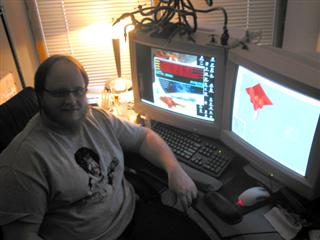 Here Shane Gurno, Human Head co-founder and modeler, taking a break from working on a model in Prey.
Here Shane Gurno, Human Head co-founder and modeler, taking a break from working on a model in Prey.

Click the screenshot to watch Prey in action on the videos page!


Additionally, if you are a gaming news website, and wish to be updated directly with notification of these updates, please email us with a link to your website and a request to be added, and we'll email you with the next update.
Posted by Joe Siegler at 2:07 PM
|
 |
 |
 |
 |
 |
Pretty Please, More Prey Previews!
Another day, another batch of Prey previews. Today we're bringing you some more previews, bringing the total batch we've posted in the last 3 days to 15, and that doesn't even include the series from last week by 1up. Anyway, today's batch includes Voodoo Extreme, Games Radar, Totally 360, Next Generation, and a series followup by 1up. I'm sure you don't want to hear me jabber on with more bad puns or phrases with the letter "P" in them, so we'll just get to the picked pack of plentiful Prey previews.... ;)
1) Games Radar Preview
Prey is stuffed with crazy ideas, from the living world you're in to the supernatural powers of your characters.
Our time romping through the game's astonishing sci-fi environments reveals a shooter of considerable promise.
The levels themselves are striking in their organic, pulsing nature - the ship is not only alive but sentient, paying you more attention as you progress.
The modified Doom III engine, the best thing around at Prey's 2001 inception but since surpassed, does not hold Prey back. It looks astonishing.
2) Totally 360 Preview
The first thing that struck us was when you get your hands on Prey's single player and multiprey is that they are both pretty amazing! You must experience Prey in full to really appreciate and get a real understanding of the sophisticated game play mechanics that are put to use.
Prey's Multiprey introduces you to dynamic and well thought-out multiplayer experience encapsulating multiplayer fun as gamers around the world will really experience what it's like to hang from ceilings stalking your opponents as they run around anxiously on the ground below you.
During the presentation we played a number of gravity defying levels and we noticed in Prey's Multiprey it will be near-enough impossible to camp, great news for gamers anxious to really engage in Multiplayer battles online.
To give you an idea of what you’ll be facing in Prey in the months to come let us make the following example: What do you get if you blend a highly modified Doom 3 Engine, with the remarkable Unreal Engine 2? Something pretty close to Prey… The wait is going to be well worth it, of course when it’s done…
3) Voodoo Extreme Preview
You can never completely die. Even if you opt to be a total lazy bastard during the Death Walk, you'll pop back into the real world with enough health to get by. Enemies will typically move away from your body or turn their back on you after killing you to give you a little breathing room when you return.
The Leech gun is the BFG9000 of Prey. You get it, use it, things die in fun and exciting ways.
The developers were very adamant about their removal of reloading. Partly because it's one less key to bind, and partly because it streamlines the game a little more.
The developers wanted to focus on the single player aspect of the game, so instead of stretching themselves thin on too many crappy gameplay types for multi player, they stuck to the basics. You like deathmatch? Good. Team deathmatch? Better. Capture the Flag, Assault, etc? Too bad.
Prey looks like it could be a big hit when it's released sometime mid year for both PC and Xbox 360.
4) Next Generation Q&A with Chris Rhinehart
Q: Do you think the pretty screenshots may lead some gamers to think this game is all looks?
A: Actually, when we first put up screenshots, we had a lot of people commenting that it looked like Doom 3. I don't know why that has a bad connotation, because I thought Doom 3 was a fantastic-looking game. When we brought out the E3 video, we wanted to show all the sorts of gameplay that showed what makes us different, that we have all this unique stuff and are really pushing things. Of course, there is some concern, because it is a really crowded market. But, the main thing that we knew we had was 3D Realms' muscle.
Q: What about the Revolution? Would Human Head be interested in developing for that system?
A: I'm not going to rule that out. It is pretty interesting. I'm really, really curious to see what they do when they unveil it and actually start showing off a lot more games and let people get hands-on with it. It'll be interesting to see how it turns out, especially with the weird little first-person-shooter controller gizmo that they have.
Q: What's up with the Cherokee in space storyline?
A: The story is one of those things that really evolved throughout the game's design. From the original version of Prey to the Human Head version, really the only main thing that came across in terms of story are the fact that the main character is Native American who is abducted by aliens and wants to rescue his girlfriend.
5) 1up's Prey Post Portem
This one isn't really a Prey Preview, it's a followup to the series 1up ran last week. Garnet Lee from 1up.com sent me this link and said, "It's our Production Artist's blog and she goes through the evolution of the Prey cover and all the prototypes we worked up.". Check this one out too, if you didn't see it, you definitely want to check out Prey's Week of Prey Coverage.
Posted by Joe Siegler at 11:30 AM
|
 |
 |
 |
 |
 |
Plenty More Prey Previews
Yes, the floodgates have most definitely opened. In addition to the 7 Prey previews we posted last night, this morning brings three more of them. You'll want to check them out, too. This time the previews are from Boomtown, Total Videogames, and Yahoo! Gaming.
Check 'em out:
1) Boomtown
The weapons on offer are biological in nature rather than simply being mechanical. For example little starfish like crawlers are explosive, pull off their legs and throw them like grenades. Or leave a few legs on them and they become sticky bombs.
Prey starts well, we watch through Tommy’s eyes as he, his girlfriend and grandfather are transported through the alien spaceship on a monorail conveyer. It’s reminiscent of the train ride at the beginning of Half-Life, albeit this time we’ve much more gore.
Now onto the multiplayer and I can report that it’s really good fun.
So far Prey is looking like it's going to be a solid first-person shooter with a few novel twists.
2) Total Videogames
Prey is shaping up to offer a first-person-shooter experience quite unlike any other.
Additionally Tommy can also make use of Spirit mode, which promises to be the game's biggest innovation along with Wall-Walking when it comes to puzzles and level designs.
Prey continues to distance itself from other first-person-shooters when it comes to health pick-up's; instead of the traditional first-aid kit or the increasingly popular wait and heal system, Prey features certain spots on the ground which replenish health when Tommy is near. The crucial difference comes from the fact that the enemy can make use of these as well, and as such there's a new dynamic on the action whereby you'll want to make sure the enemy don't steal health away from you and make the encounter much more difficult.
Perhaps the biggest surprise is just how much they've thought about level designs, a skill seemingly forgot in some modern first-person-shooters.
3) Yahoo! Videogames
Prey takes the traditional multiplayer deathmatch and turns it on its ear.
By putting the walls and ceilings into play, the developers can take a standard-sized deathmatch map and make it feel a lot larger.
Perhaps the craziest [multiplayer] level we played featured the spherical gravity at work. This level takes place on a huge spheroid divided up by rooms and hallways. If you could run in a straight line, you would eventually return to where you began, so it's essentially a small planetoid.
Prey should also sound pretty good (at least, to older gamers) thanks to a soundtrack filled with Blue Oyster Cult, Judas Priest, and Heart.
The production values are first-rate and the multiplayer is fast and furious. This is definitely the game to keep an eye on if you're a shooter fan.
More previews as they come in...
Posted by Joe Siegler at 7:47 AM
|
 |
 |
 |
 |
 |
Plenty of Prey Previews Popping up
Well, it appears that some floodgates have opened in regards to Prey previews today coming from the press tour a couple of weeks ago. Last week we had the excellent 5 day series from 1up.com, and now we have half a dozen more Prey Previews available online.
We've got previews from Shacknews, two previews from IGN, as well as the sites Kotaku, Computer & Video Games, EuroGamer, & and Hexus. Make sure to check 'em all out. Let's get right to them, with some quotes from each.
1) Shacknews' Preview:
To some extent, Prey's protagonist was born out of a desire to create a strong contrast to Duke Nukem, the archetypal gung-ho buck-stops-here video game character. Tommy Tawodi is indeed an archetypal antihero.
This really wouldn't be Prey without crazy interspatial portals, the technology featured prominently in the original E3 videos. It's possible not only to see yourself in the interconnected portals (from varying angles) but to follow yourself, and even shoot yourself through the portals as well.
In a particularly inspired turn, the team actually hired Coast to Coast radio host and nationally known UFO theorist Art Bell. At various points throughout the game, Bell and his notoriously fanatical call in guests can be heard discussing the invasion.
The Escher-esque architectural design, the arbitrary gravity, and the spirit walking mechanics are very unique and seem well implemented. If the whole game delivers the constantly changing experience that's been promised, Prey should be one hell of a ride.
2) IGN's PC Preview:
Far from wanting to be humanity's greatest hero, Tommy just wants to find his lady and hightail it back to the planet one way or another. So begins the violent tale of young Tommy, an angry young man with a mission and a wrench.
We've seen this game before, but only in video form. What was shown at E3 last year was very impressive, especially since we weren't expecting anything so grand. Seeing it again only confirmed the fact that this game should be something special.
The Sphere is a disgusting place. It's alive and the game is played out inside of it. Therefore, you can probably imagine all of the slimy wet runny textures spread across the levels. Doors are like nasty sphincters (in fact, Chris called them sphincdoors), pimple like mounds on the ground vomit up juices and waste, health looks like misty spores out of smaller pimples, and some of the Sphere's creatures serve as anti-bodies towards potentially harmful invaders like Tommy.
Multiplayer is just plain wacky. Levels are specifically designed to take advantage of Prey's uniqueness. It's a bit disorienting at first. The act of simply getting from place to place can be an adventure on its own before getting a handle on which direction is up.
Prey is looking very good at this point. If the whole game is as jam packed full of odd little goodies as the demo was, first-person shooter fans are in for a treat.
3) IGN's Xbox 360 Preview:
As some of you might already know, the story of Prey centers around Tommy, a Cherokee garage mechanic who loves his girlfriend Jen. Unfortunately for both of them, something about their town really pisses off some aliens, so Tommy and Jen get beamed to their bizarre craft.
Human Head showed off little bits and pieces of the single-player campaign on a PC, and it's obvious that they're making use of their "living ship" concept. Enemies often sprout right out of the floor, you'll find some doors ("sphincdoors") bear an uncomfortable resemblance to a certain portion of the body, and many of the floors and walls will actually bleed when shot.
What's really cool is that the portals are not visible from behind. So if you walk around to the other side of the temporal door, it will seem as though nothing is there. You can even walk through the back of it to no effect, yet when you turn around it's still there.
We played several DM matches across three maps. Human Head is expecting to have between eight to 10 maps in the game, and those we got to try out seemed like an excellent variety of the game's unique environmental elements.
To prepare for its release, you might want to start getting used to the idea of checking the ceiling every time you enter a room.
4) Kotaku's Preview:
We told you last week that 22 first-person shooters would be released this year. By any measure, that’s a lot of games for one genre. Any developer brave enough to compete in this field better have a novel premise. Judging by one hour of play time, I think Prey has enough going for it to stand out in the crowded field.
As the game progresses, the hero, Tommy, gets more in touch with his ancestory and spirituality. By doing so, he gets help from the spirit of his grandfather who gives him crucial clues.
It’s been a long time since playing a shooter made me nauseous, but having your perspective constantly flip 90, 180, or 360 degrees really messes up your sense of balance (those of you who bought a big-screen HDTV along with the Xbox 360 better keep barf bags handy).
I also have to give props to the game designers for avoiding FPS cliches. When you die, you don’t just restart as if nothing happened. You enter a spirit world where you have to fight to get your spirit back into your body. It’s a neat concept. And I didn’t see any crates or exploding barrels, at least not in the demo.
5) Computer & Videogames' Preview:
A cursory glance in the direction of Prey would probably have you, understandably, dismissing the game as just another first-person shooter - after all, it's not like there's a drought of them on PC at the moment. However, five minutes with the game will change all that.
After your abrupt removal from the Earth, you're introduced to Prey's Dyson Sphere, which proves to be more of a dynamic, organic entity than your conventional spaceship - a frankly ingenious concept which offers up all manner of possibilities for the development team, in terms of unique gameplay features and puzzles.
As any FPS veteran knows however, a shooter's only as good as its guns and, thankfully, this is where Prey really excels.
Some of the coolest things we sampled: a flyable space shuttle section complete with lasers and tractor beam, low-gravity asteroid gunfights, an insanely interactive public toilet (complete with intergalactic condom dispenser), playable arcade machines and a jukebox featuring fully-licensed music. All of which are merely impressive embellishments on an already extremely solid and well-rounded shooter.
Combine Prey's excellent multiplayer features with its impressive looking single-player game and you've got yourself the ingredients for one of the biggest games of the year.
6) Eurogamer's Preview:
We're initally intrigued by the title screen, which reveals there are two difficulty settings: "Normal" and "Wicked".
Like all the cut-scenes in the game, the opening FMV is presented from Tommy's perspective - so you see through his eyes as he watches his loved ones being hauled around.
But much more interesting are the weapons which, like the ship, combine plain old technology with all sorts of organic weirdness. Take the Leech Gun, for example, which has four different fire modes. By attaching it to the various "leech nodes" you'll find dotted around, you can suck power out of the ship and charge it up.
These elements (portals) really come into play in multiplayer mode, as we found out when we got to go head-to-head in a deathmatch (the only other MP mode is team deathmatch; there's no point trying to capture silly old flags when the laws of gravity can change at any moment).
Who would have thought that a game about a garage mechanic trapped on a spaceship with only a dead Grandad and a talking hawk for company could turn out to be so intriguing?
7) Hexus Gaming's Preview:
Walking us through the as yet unfinished opening level, the first thing that strikes you about Prey is not the graphics (after all, these will be dependant on your machine to some extent) but the huge amount of interactivity built into the game. Simply put, everything can be fiddled with.
The thought put into the level design and mechanics of the game becomes apparent with the spirit walking when you see some of the later levels. Not only are there barriers such as force fields that can be crossed, but there are also bridges and gangways that just aren’t there in the real world.
This whole ‘alternate reality’ thing that Human Head have developed lends a superbly original puzzle element to Prey which, from what we’ve seen, lifts it way above a bog standard FPS.
Prey is shaping up to be something rather cool and refreshingly different. The storyline, though a little clichéd to start with soon pans out into something far more involving than the ‘loner saves the world’ stuff we’re used to and from what we’ve seen, Prey is going to have been well worth the wait.
Posted by Joe Siegler at 5:10 PM
|
 |
 |
 |
 |
 |
The Apogee Legacy #5 - Frank Maddin
Today our "Apogee Legacy" Interview series continues with its fifth edition, this time with Frank Maddin, author of a few games with us. His first game with us was 1991's Crystal Caves, and then followed it up with 1993's Monster Bash. After that, he teamed up with Jim Norwood to do 1997's Shadow Warrior. Frank also briefly did some work with is on a fourth game after Monster Bash called "Cybertank", but it was abandonded early on in development (was to be a tank game with a 3D engine). Additionally, Frank is one of the few developers we've had to ever get dressed up as one of their characters (see the pictures below).
Frank now works at Microsoft, and was happy to participate in the interview series. Hereeeee's Frank! :)
The Apogee Legacy
Past Pioneers of the Shareware Revolution
Issue #5 - Frank Maddin
1) How did you first come in contact with Apogee?
I met George Broussard in Lufkin, Texas. He calls it a "stinky little town". His family had moved there from Dallas. I'd lived there most of my life.
I had a Commodore Amiga (Jack Tramiel was the devil the ST was crap) and knew very few people in town with one. So I put an ad in a local trade paper and his mom called me. We became good friends - his mom and I - eventually we let George hang out with us. :-) We commuted to college together in nearby Naca-nowhere.
Scott was a friend of George from back in Dallas and would come down to visit occasionally with Terry Nagy. We'd all go play tennis or something. Of course, I was by far the best tennis player and there was usually tears and gnashing of teeth, but I digress.
When George graduated he and his family moved back to Dallas. Fast forward a year or two and I had a job at Lockheed that I didn't like, and George was getting ready to compete with Scott because Apogee was starting to take off. I told him to send me some code and I'd take a stab at it.
A number of months into the development of Crystal Caves, George joined Apogee and Crystal Caves became an Apogee product.
2) Was there a reason you decided to work with Apogee, say versus going on your own or working with another company?
I'd just sort of fallen into game development. I doubt I could have gotten a job at a real game company, or started my own at that point.
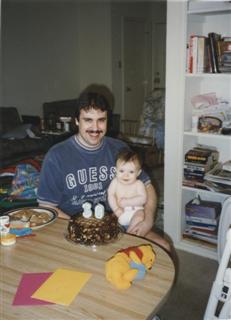
|
|
Frank with his son back in 1991
|
3) Looking back, was there anything Apogee could have done better, regarding the marketing and distribution of your game?
Back in the day, the BBS was the main distribution method. The main form of marketing was mailing out to previous customers. Once they built up a reputation, that was pretty much all they needed to at least get new people to download and try new games. The 3 episode hook got people to pay. Worked pretty well for the time.
4) Do you think your game was made better or worse by working with Apogee?
The level of support varied from game to game. Sometimes tools, sometime design, etc. They generally had good design input. If I was making the game in a void I'm sure it wouldn't have turned out nearly as well.
5) Apogee had a policy of letting the designer or studio retain full intellectual property rights to their game. Nowadays, it's rare to find a publisher who allows this, especially if the publisher is providing the funding. Do you believe that it's best for the creator to retain IP rights? Why or why not?
Well sure, you should keep the IP. If the game is a hit it might be worth something. Seems to me it's about who has the upper hand and the position they are in. How badly does the publisher want the developer? How far along is the game?
5a) And if applicable, have you benefited from retaining ownership of your own IP?
I don't think it's highly applicable to me. Seems like with my projects it's kind of a joint ownership thing with Apogee. Of course I could do something with it if I got permission, or payed them something from profits.
5b) Do you think there'll ever be a sequel to your game(s)?
Probably not. I have the most fondness for Monster Bash, so if I could choose, that would be the one.
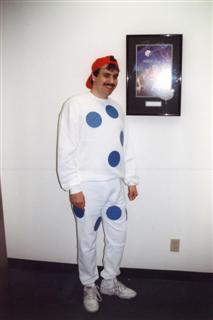
|
|
Frank dressed up as Johnny Dash from Monster Bash at the 1996 Apogee Halloween Party
|
6) Is there any story/incident that stands out as interesting during your time associated with Apogee?
There is an interesting "brush with greatness" with the author David Gerrold.
The fellow that wrote the script for the Star Trek episode "Trouble with Tribbles", David Gerrold, actually played and liked Crystal Caves. Mr. Gerrold, like Jerry Pournelle, was also a computer guy and wrote articles for computer magazines. I was reading a computer mag (I think it was a programming mag called PC Techniques) and I noticed that the author mentioned Crystal Caves, talked about it a bit, called out that the first episode was "Trouble with Twibbles" and seemed to think that was funny. At the time I thought it was cool but I didn't realize the significance. Not much later I think I picked up a SF book he'd written and saw that he wrote the Star Trek episode. I was pretty floored. That probably had something to do with his mention.
There is also the "Great Romero Misunderstanding"..
My best work was probably the snake in Crystal Caves. There is a story about that. At one point during development we'd flown to see id software (involved with Apogee) for business reasons and I'd shown CC to them. Later, I heard that John Romero thought I had stolen the snake from one of his earlier games it looked so similar. The truth was that I hadn't seen that game and that it was the only way I could figure out how to do a snake in 16x16 pixels. But it kind goes to show you the limitations can really influence what the art is. So John, REALLY, I didn't steal your snake! Swear to GOD mode. I just know this will get back to him.
I'm sure there are many others lurking but I can't dredge them up.
7) Apogee was an early pioneer in terms of teaming up with external designers and studios, and continues to do so even to this day (currently working with Human Head Studios on Prey). Why is it that so few other studios do this (mentor and fund outside projects with lesser known teams)?
Seems like a good thing. I'm not too up on these working relationships these days. Japan seems to have more separation of design and development, but that's maybe not quite the same thing.
8) What the biggest difference in the industry nowadays versus when you worked with Apogee?
I remember George said once, something like "Making games is too hard. id came along and screwed it all up. I'd have been happy making side scrollers forever". That was probably back in 94 or 95 or something. It's just gotten harder. It takes vast effort, lots of people, and oodles of resources.
9) What have you been doing since your time with Apogee?
Raising a couple of kids, enjoying life. Still making games. The majority of my time has been spent at Digital Anvil/Microsoft.
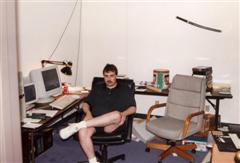
|
|
Frank at his office at 3DR in 1997.
|
10) If you're no longer making games, have you thought about returning to this industry? If not, why not?
N/A
11) Looking back, are there any missed opportunities that you wish you'd have jumped on?
Can't think of any large ones. Shipping earlier on all games would have been good.
Should have put a better level as the first level of Monster Bash. There were many that were better. Wouldn't have programmed the bug that didn't allow you to finish level 4 :-)
12) Other than your game(s), what's your favorite game released or produced by Apogee (or 3D Realms)?
Commander Keen. It opened my eyes to seeing the PC as something that could play games like a console. I didn't have a high opinion of the PC at the time, being an Amiga person and all.
12a) And what's your favorite 2-4 games released by anyone else?
Fairy Tale Adventure, Splinter Cell, Call of Duty
13) Is there anything else you'd like to add about your time here or to fans of your title(s)?
I had a lot of fun in those early days developing, and I hope you enjoyed playing.
 The Shadow Warrior Team in 1997 (L-R):
The Shadow Warrior Team in 1997 (L-R):
Frank Maddin, Lee Jackson, John Galt, Keith Schuler, Jim Norwood, & Stephen Cole.

Screenshot from early build of Frank's cancelled Cybertank game.
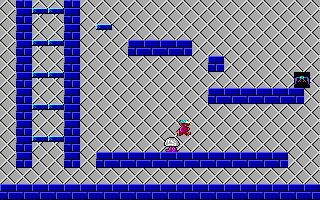
Screenshot from early beta of Crystal Caves.
Thanks to Frank for helping out with the interview series. We still sell all the games released with us during his time here (Crystal Caves, Monster Bash, & Shadow Warrior), so make sure and check them all out on our Games Page.
If you want to read more about Frank, you might also want to check out this interview done with him over at the "Perilous Crystal Caves" fansite, where he talks more about the development of Crystal Caves.
Make sure and tune in again next Monday morning, when we bring you the next in our Legacy Interview series.
Posted by Joe Siegler at 11:58 AM
| Discuss this story on our forums
|
 |
 |
 |
 |
 |
Prey Weekly Development Update #4
Welcome back, everyone. This week is going to be another divergence from the usual updates. Instead of talking about specifics this week at Human Head, I'm going to talk about something that happened a few months ago - namely, the voice recording sessions.
After spending a few months listening to audition tapes for the various characters in the game, we nailed down the final list of actors in Prey.
Of course, many of the characters interact with each other in-game, so we wanted to record them at the same time. Luckily, their schedules coincided so we were able to fly all the actors out to the recording studio during the same week.
That studio we chose was one that 2K Games had used in the past - Rick Fox Studios in Cincinnati. So, last year Ed Lima (Human Head's Sound Director) and I flew out to Cincinnati to meet with the actors and go through the process of the initial sound recording session. There are several pictures in this article, and you can click on any of them for a larger image.
 Rick Fox Sound Studios
Rick Fox Sound Studios
Recording went very smoothly - all the actors were total professionals and usually nailed their lines after only a few takes. In fact, we were ahead of schedule the entire trip.
The process went like this: The actors were given the script to read through the day before. Then, at the actual session, they were given shooting scripts (which is variation of the full script, which contains each line, numbered and broken down by scene). Before recording each scene, Ed and I explained the situation and the character's motivation as well as the general reaction we'd like out of them (anger, fear, sorrow, etc). We'd then have the actors run through their lines three times. If we were happy with them, we would move on. Otherwise, we'd explain the changes we want and the process starts over again until we were happy.
Of course, the real test for the voice acting is actually getting it in game - if the recordings don't work out, then that calls for a pick-up session where we fly the actors out again (typically for a day or two) to re-record the lines and any new lines we may need.
The first evening there we met with Michael Greyeyes, who plays our hero Tommy. Over dinner we discussed the game with him (since due to secrecy, we only gave the actors small amounts of character information during their auditions) and explained how the week would play out. Since he's the main character, we'll need him to be there the whole week to interact with all the other characters.
The next actor to arrive was Crystle Lightning - who plays Jen in the game. We wanted her and Tommy in right away so we had plenty of time to record their lines both apart and together. When she first showed up, we had her record some of her lines in which no other actors were needed - general comments, pain sounds, screams, etc.
In hindsight, we should have recorded her screams last, as we became worried she might blow out her voice right away. But, she has a damn good voice and was careful not to overdo it with the screams.
Next, John William Galt showed up to record the voice of Grandfather. You may remember John as the voice of Lo Wang in Shadow Warrior, plus he was the original voice of Grandfather in the E3 Prey video from 1998. We searched around for other voices for Grandfather, but honestly, none were as expressive and unique as John's rendition of Grandfather.
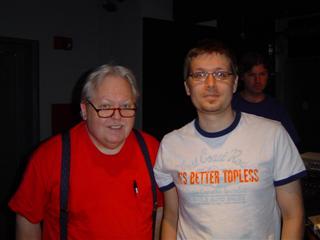 John William Galt posing with me (with Rick the sound engineer in the background). My shirt, of course, refers to convertible cars.
John William Galt posing with me (with Rick the sound engineer in the background). My shirt, of course, refers to convertible cars.
Wav File: [ Grandfather admonishing the player. ]
Over the next couple of days, things went pretty fast, as we quickly recorded the other characters in the game (which tie in heavily into the narrative, so I'm not going to reveal them just yet). But those characters were played by Tyne Turner, Eleni Valasis, and Lee Ernst (who you may remember as the voice of both Odin and Loki in Rune). They all did an amazing job as they nailed their lines.
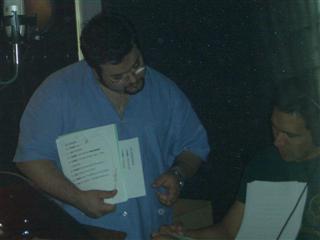 Ed instructing Michael on the next scene
Ed instructing Michael on the next scene
At the end of the week, the recording session was over. We had all the lines we needed to do a first-pass implementation in the game (up until that point we had speech synthesized robot voices and various voices of people around the office in the game!). But, before going home had to explore the fine city of Cincinnati. We wandered into a nearby bar and relaxed with a few drinks and played some pool.
 Crystle Lightning posing while we played pool
Crystle Lightning posing while we played pool
Until next time - stay out of trouble.
Chris Rhinehart - Prey Project Lead
Human Head Software

Click the screenshot to watch Prey in action on the videos page!


Additionally, if you are a gaming news website, and wish to be updated directly with notification of these updates, please email us with a link to your website and a request to be added, and we'll email you with the next update.
Posted by Joe Siegler at 11:56 AM
|
 |
 |
 |
 |
 |
Final day of 1up's Prey Coverage
 Today is Friday, and 1up has posted the fifth and final entry in their Week of Prey Coverage. This one is entitled "Come Out and Play", and focuses on the multiplayer aspects of the game. Yesterday's article was about the single player side of things, so it makes sense that today's article would be about multiplayer. Let's get to a bit of what they had to say: Today is Friday, and 1up has posted the fifth and final entry in their Week of Prey Coverage. This one is entitled "Come Out and Play", and focuses on the multiplayer aspects of the game. Yesterday's article was about the single player side of things, so it makes sense that today's article would be about multiplayer. Let's get to a bit of what they had to say:
it feels like the designers have hit on a good balance of manic disorientation and playability. You can imagine that their first inclination might have been to see just how insane a level you could create. From playing in these three levels it seems pretty clear that going that route would have just created an infuriating mess. But to help soothe any concerns that they held back, the last word that will come to your mind in describing them is restrained.
With live opponents, Prey quickly becomes one of the most seriously intense games of cat-and-mouse around. In a way, multiplayer may live up to the title of "Prey" better than single-player.
That could be the most fitting vindication for the return of Prey a decade after its inception -- rediscovering the simple pleasure of a good online frag fest.
In addition, there's a little side article in this about the Xbox 360 version of Prey and how it will be released at the same time as the PC version. Venom Games in the UK are handling the 360 port, and a little of the work that is going into the 360 version is covered here as well. As has been the case with the other days in the series, there has been a video with the article. This one (shockingly :)) is about multiplayer, and shows some multiplayer Prey being played. You'll definitely want to check that out.
This is the final day of this series, and as such, there is a little extra article called "Parting Shots", which talks about (in their words) "two dudes reminiscing about what once was, and what could be". It's Dan Harnett and James Mielke talking about Prey's past and future, as well as a bit about Duke Nukem Forever.
This was an absolutely wonderful series covering all aspects of Prey from top to bottom, and if you haven't been keeping up with all of it, you should go back and start reading all of it from the top. You can reach the main page of this article at 1up's site here: http://prey.1up.com. Thanks to 1up for giving the fans such a good week.
We expect to see more Prey goodness appearing online soon from other gaming news sites, too. ;)
Posted by Joe Siegler at 10:38 AM
|
 |
 |
 |
 |
 |
Day 4 of 1up's Prey Coverage
Today is Thursday, time to bring you the next installment in 1up's Week of Prey coverage. Today's article is entitled "Better Man", and it focuses on the single player aspect of Prey. There's plenty of detail as to how the story is intertwined with the action, how various parts of the game are introduced to you, and just tons of detail. Let's get to the quotes:
From what was on display here, there is every reason to hope that its one-two punch of design and story will deliver a knockout.
[Tim] Gerritsen says it was important not to, "throw it in your face all the time that he's Cherokee. That would cheapen the experience; that would cheapen the character." It also allows Tommy to be more of a real person than simply an icon in a game.
Before you get too concerned that this devolves into a standard, sappy love story or some sort of preachy, philosophical thing, don't be. "This is still a first-person shooter," Gerritsen makes sure to emphasize, "All of that is completely secondary to the fact that this is an action first-person shooter."
One of the most interesting weapons is a leech gun that draws power from nodes around the ship. Depending on the node, you get different projectiles/effects. For instance, a bright white node turned out to be a freeze power-up whereas a bright red one provided a rapid-fire machine gun.
In addition to the really meaty single player stuff, there's also a secondary video interview with Chris Rhinehart in which he talks about single player gameplay. You'll definitely want to check all of this out over at http://prey.1up.com.
Posted by Joe Siegler at 2:58 PM
|
 |
 |
 |
 |
 |
Day 3 of 1up's Prey Coverage
It's Wednesday, the third day of the week, which means that it's time for Day 3 of 1up's week of Prey coverage.
Today's article is entitled "Use Your Illusion". The focus of this article is on various aspects of the game's technology. Based on the Doom 3 engine, Prey makes several improvements over Doom 3's tech, some of which are detailed in the article. There's a lot said about the famed "Portal Technology" in Prey, even going back to giving some props to the late original Prey programmer, William Scarboro; showing how the concept is now vs its original incarnation.
Here's some tidbits from the full article for you to check out:
"Our target minimum spec machine at the moment is a 2GHz P4, 384MB RAM, and a DirectX 9 graphics card, and the game will scale to trade off quality for [playability on] lower-end systems quite well. For the extremely high resolution and quality settings, however, you'll need the usual monster." (To said monster-owning crowd, yes, Prey will proudly support dual-core setups and more.)
"It's [Prey's Tech] allowed us to use compressed normal maps even at high settings that look as good as the uncompressed normal maps," says McArthur. "Because of this, our medium-quality settings will look like Doom 3's high-quality textures, and our high-quality normal maps can have twice the resolution. It's been a huge gain for us."
Couple gravity with juggling orientations and you get another of Prey's curious gameplay variants: wall walking. "Wall walking is the ability to walk on marked surfaces within the game regardless of their orientation," explains McArthur. "We use curved surfaces to great extent, allowing you to travel in directions that would normally require an elevator or ladder, as well as spaces you'd simply be moving through in another game.
You'll want to check this out not only for the article on the game's tech, but for the fact that there are some new screenshots as well. You can check those out over here.
Posted by Joe Siegler at 1:39 PM
|
 |
 |
 |
 |
|

 |
